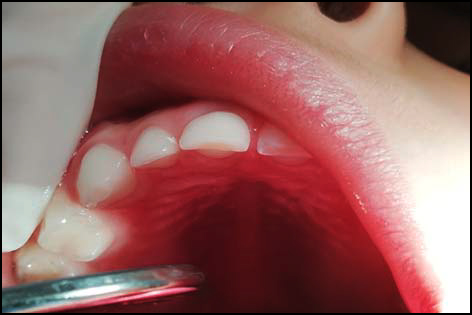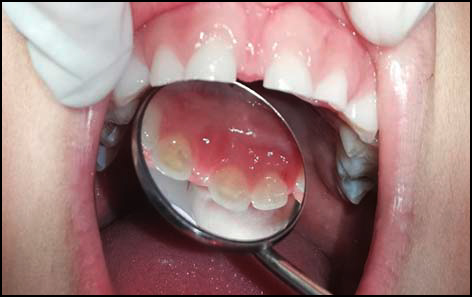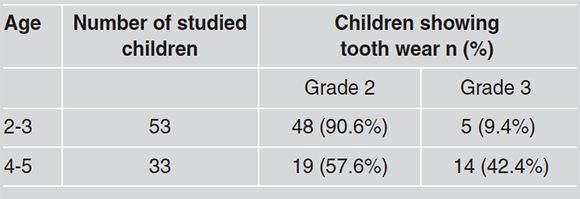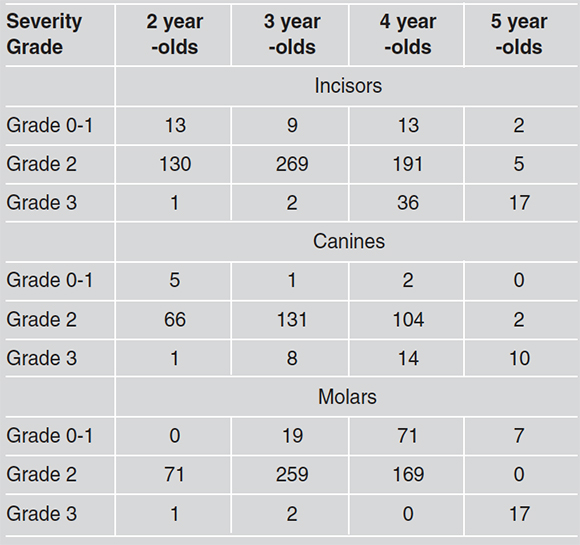Services on Demand
Journal
Article
Indicators
-
 Cited by SciELO
Cited by SciELO
Related links
-
 Similars in
SciELO
Similars in
SciELO
Share
Acta Odontológica Latinoamericana
On-line version ISSN 1852-4834
Acta odontol. latinoam. vol.32 no.2 Buenos Aires Aug. 2019
ORIGINAL ARTICLE
Characteristics and severity of tooth wear in 2 to 5-year-old kindergarten children in Medellin
Facetas de desgaste y características de severidad en niños de 2 a 5 años de un jardín infantil, Medellín
Sonia Pineda-Higuita1, Verónica Saldarriaga-Bolívar1, Catalina González-Penagos1, Sarah Moreno-Callejas1, Angie Yaneli Murillo-Murillo1
1 Fundación Universitaria Autónoma de las Américas. Facultad de Odontología. Medellín, Colombia
Received: January 2018; Accepted: April 2019
ABSTRACT
The aim of the present study was to identify the characteristics and severity of tooth wear in children aged 2 to 5 years attending a kindergarten in the city of Medellin.
The study population comprised 92 children aged 2 to 5 years attending a kindergarten in Medellin; the final sample included 86 children selected using a non-probabilistic sampling method. All assessments were performed using the index devised by Hansson and Nilner (1989).
Prevalence of tooth wear in the studied population was 100%. The observed results confirm previous findings showing that the severity of tooth wear is proportionally related with increase in age, and is mainly due to the physiological wear of teeth. No significant differences in tooth wear facets were observed among the different types of teeth (incisors, canines, molars). It is necessary to develop validated, precise, and comparable indices that allow establishing the etiology and orienting treatment of non-physiological tooth wear.
Keywords: Tooth wear; Dentition permanent; Children.
RESUMEN
El objetivo del estudio fue identificar las facetas de desgaste y las características de severidad en niños de 2 a 5 años de un jardín infantil de la ciudad de Medellín.
El estudio incluyó 92 niños entre los 2 y 5 años de un jardín infantil de la ciudad de Medellín, con una muestra final de 86 seleccionados a partir de un muestreo no probabilístico. Se utilizó como instrumento el índice propuesto por Hansson y Nilner (1989).
El 100% (86) de los niños evaluados presentaron facetas de desgaste. Los resultados encontrados confirman datos previos en cuanto a que las severidades de las facetas de desgaste dentario están relacionadas proporcionalmente con el aumento de edad y se deben principalmente al desgaste fisiológico de los dientes. No se encontraron diferencias significativas en la prevalencia o severidad de desgaste entre los grupos anatómicos dentarios (incisivos, caninos y molares).
Es necesario establecer índices validados, precisos y comparables para evaluar la etiología y orientar hacia la solución de las causas no fisiológicas.
Palabras clave: Desgaste dentario; Dientes permanentes; Niños.
INTRODUCTION
Among other factors, new eating habits, tooth brushing techniques, and occlusal overloading, have given rise to a new field of oral care within pediatric dentistry: non-carious lesions. In this regard, understanding the difference between normal, or physiological, and pathological patterns of tooth wear contributes to preventing greater damage to the tooth structure at an early stage and to identifying and solving the underlying causes. Hence the importance of early diagnosis and of determining damage severity, which is directly associated with the number of affected teeth and the involvement of the tooth structures (enamel, dentin, and pulp)1.
Tooth enamel of deciduous teeth contains a lower proportion of mineral salts and is therefore more porous, which can lead to greater tooth wear. Tooth wear facets reveal the mechanical wear of the occlusal surfaces resulting from attrition forces, and are currently an emerging problem within the diseases involving the hard tissues of the teeth.1-3
Most studies on tooth wear reported in the literature were performed in adults, whereas tooth wear in deciduous teeth has been less analyzed4.
In addition to the normal functions of the mouth, other pathological factors such as structural alterations of the teeth, malocclusions, and bruxism, can cause tooth wear of deciduous teeth. The association between tooth wear and emotional stress in children with behavioral disorders is well documented.5
Although it has been established that dentin exposure is the best indicator of tooth wear severity6, it is important in clinical practice to assess other patient-specific factors in order to differentiate between physiological and pathological causes.
In view of the above, the aim of the present study was to identify the characteristics and severity of tooth wear in 2 to 5-year-old children attending a kindergarten in the city of Medellin in 2016.
MATERIALS AND METHODS
A descriptive observational cross-sectional study was conducted. The study population comprised 92 children whose parents agreed to participate in the study and who signed the corresponding informed consent form in keeping with the Declaration of Helsinki. The project was approved by the Research Ethics Committee (CEI) (Resolution N°15. October 26, 2015) of the Autonomous University Foundation of the Americas.
A structured questionnaire eliciting sociodemographic information was filled in by the children’s parents, and served as the primary source of information.
The team included three researchers and two assistants, all of whom were trained and calibrated (inter-examiner Kappa index: 0.81)7. After tooth brushing, each child was clinically examined by one dentist and one assistant. Dental examination was performed under a direct source of light and using sterile cotton rolls to keep the area dry.
Children aged 2 to 5 years with complete deciduous dentition were included in the study. Teeth presenting caries and/or extensive restorations were not evaluated. Children with behavioral disorders or who refused to undergo oral examination were excluded.
Diagnostic assessment of tooth wear was performed using the following scale devised by Hanson and Nilner, including grade 0 (no wear), as referred by Rendon5
Grade 1: Enamel wear facets
Grade 2: Enamel wear facets and islands of dentin measuring up to 1mm in diameter.
Grade 3: Wear of the incisal surface; wear facets are pronounced and extend in a lingual or buccal direction.
Grade 4: Tooth wear facets involving the pulp chamber.
RESULTS
A total of 92 children were evaluated, six of whom were excluded due to multiple active caries (n=3) and behavioral disorders (n=3). Hence, the final study sample comprised 86 children who complied with the inclusion criteria.
Sixty percent of the children were aged 2 to 3 years, and the remaining 40% were aged 4 to 5 years; 56.5% were boys.
The data regarding the sociodemographic factors showed that the majority of children were under the care of women who had finished high school and were home makers. Most families lived in apartments.
One hundred percent of the studied children had tooth wear. Most of the studied children (78%) had moderate, grade 2, tooth wear (Figs. 1 and 2). Grade 3 wear facets were observed in a smaller proportion of children (22%), and were found to increase with age (Table 1). No differences were observed between sexes.

Fig. 1: Grade 2 wear facets involving the enamel of the first molar and upper incisors.

Fig. 2: Enamel wear facets and islands of dentin on the upper incisors.
Table 1: Maximum severity of tooth wear in each

Analysis of the degree of tooth wear according to type of tooth showed the presence of grade 2 wear in 86% of incisors, 88% of canines, and 81% of molars. Thus, the incidence of tooth wear was similar in all anatomical groups of teeth (Table 2). In the present study, tooth wear grade 0 and 1 were grouped in the same category since the aim was to focus on observable lesions. Because molars had not erupted, or fully erupted, in some of the 2 year-olds, 72 teeth that had not reached occlusion were not included in the final count of the number of studied teeth (Table 2).
Table 2: Severity of tooth wear according to age and type of tooth (Number of teeth).

DISCUSSION
The present study shows the high prevalence of tooth wear in deciduous teeth in the studied population. Given that the sample included children recruited from a single school, largely homogenous results were expected. Although the causes of tooth wear were not explored in this study, which sought to determine the prevalence and severity of the lesions, the homogeneity of the results would indicate that the observed tooth wear was mainly due to physiological processes of mastication, and it is therefore logical that severity should increase as the age of the child increases.
It has been shown that the structure of deciduous teeth is less resistant than that of permanent teeth 8. This would account for the high prevalence of tooth wear and the similar frequency of tooth wear facets and severity in the different types of teeth and at an early age.
In addition to mastication forces, other factors such as the erosive capacity of certain foods and occlusion disorders can contribute to the development of tooth wear9,10. These factors often cause lesions that involve a certain tooth or group of teeth more than other teeth, or that show a greater severity. Recognizing this type of lesion could contribute to assessing increased pulp risk as well as detecting inappropriate eating habits and abnormal occlusion, which in turn may be caused by neurological or psychological disorders that require a multidisciplinary approach11- 15. In order to discriminate expected lesions resulting from physiological processes from those caused by other etiopathogenic factors, it is necessary to have objective indicators. The index used in the present study is a semiquantitative tool that involves simple inter-examiner calibration. Nevertheless, it is necessary to reach consensus to establish a validated index with precise quantitative parameters that allows establishing adequate comparisons among studies conducted in different populations.
ACKNOWLEDGEMENTS
The authors wish to thank the children, parents, and the Kindergarten for their cooperation, without which it would not have been possible to conduct this study.
FUNDING
The present study was totally funded by “Fundación Universitaria Autónoma de las Américas”.
CORRESPONDENCE
Dr, Sonia Pineda
Circular 73 N.35-04 Medellín. Colombia. E-mail: sonia.pineda@uam.edu.co
1. Cava, C, Malatto, J, Olivares C, Rodríguez, L, et al. Prevalencia de facetas de desgaste. Kiru 2012; 9:59-64. URL: http://www.usmp.edu.pe/odonto/servicio/2012/Kiruv.9/ Kiru_v.9_Art9.pdf [ Links ]
2. Vallejo, E, González, E, Del Castillo, R. El bruxismo infantil. Odontología Pediátrica 2002; 10:135-141. URL: www.odontologiapediatrica.com/wp-content/ uploads/2018/ 05/39_9-VALLEJO.pdf [ Links ]
3. Rodríguez, B, Tamayo, A, Tobón, A. Análisis de factores asociados al desgaste dental en niños de cinco años. CES Odontología SD, 1987; 1: 7-13. URL: http://revistas.ces. edu.co/index.php/odontologia/ article/ viewFile/1806/1197
4. Álvarez, E, Arango, M, Arbeláez, D, González, C, et al. Diseño y aplicación de un instrumento para la medición del desgaste dental en pre-escolares de 3 a 5 años del Municipio de Sabaneta. CES Odontología 1998; 11:20-23. URL: http://revistas.ces.edu.co/index.php/odontologia/articl e/view/839/534
5. Rendón, A. Facetas de desgaste dentario y personalidad: revisión bibliográfica. Kiru 2015; 12: 88-90. URL: http://www.aulavirtualusmp.pe/ojs/index.php/Rev-Kiru0/article/viewFile/466/381
6. Kreulen, CM, Van ’t Spijker A, Rodriguez JM, Bronkhorst, EM,et al. Systematic Review of the Prevalence of Tooth Wear in Children and Adolescents. Caries Res 2010; 44:151-159.
7. Cerda JL, Villarroel Del LP. Evaluación de la concordancia inter-observador en investigación pediátrica: Coeficiente de Kappa.URL: https://scielo.conicyt.cl/pdf/rcp/v79n1/art08.pdf [ Links ]
8. Carvalho T, Lussi A, Jaeggi T, Gambon D. Erosive Tooth Wear in Children. Monographs in oral science 2014; 25:262-278. URL: http://www.ncbi.nlm.nih.gov/pubmed/24993274 [ Links ]
9. Corica A, Caprioglio, A. Meta-analysis of the prevalence of tooth wear in primary dentition. Eur J Paediatr Dent 2014; 15: 385-388. [ Links ]
10. Pires de Andrade, F, Sales, A, Garcia, P, Abel, Marta, et al. Nutritional status, tooth wear and quality of life in Brazilian schoolchildren. Public Health Nutr 2016; 19:1479-1485. [ Links ]
11. Torlinska, N, Mackowiak, K, Sowinska, A. Evaluation of deciduous-tooth wear in children living in the middle ages. Oral Health Prev Dent 2015; 13:149-156. [ Links ]
12. Johansson, A, Omar, R, Carlsson, G, Johansson, A. Dental erosion and its growing importance in clinical practice: from past to present. Int J Dent. 2012; 2012:632907. doi: 10.1155/2012/632907. [ Links ]
13. López, F, Castellanos,L, Martín, J, Llamas, J,et al. Clinical measurement of tooth wear: Tooth wear indices. J Clin Exp Dent 2012; 4:e48-53. [ Links ]
14. Ganss, C, Young, A, Lussi, A. Tooth wear and erosion: methodological issues in epidemiological and public health research and the future research agenda. Community Dent Health 2011; 28:191-195. [ Links ]
15. Salas MMS, Nascimento GG, Huysmans MC, Demarco FF. Estimated prevalence of erosive tooth wear in permanent teeth of children and adolescents: An epidemiological systematic review and meta-regression analysis. J Dent 2015; 43:42-50. [ Links ]














